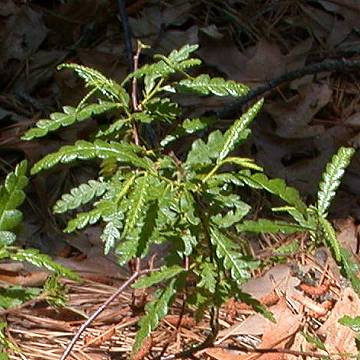

Comptonia peregrina - (image 1 of 3)
Taxonomy
Family: Myricaceae
Habitat
Sand flats and barrens, usually where fires occur occasionally.
Associates
Most frequent associate is bracken fern.
Distribution
Nova Scotia to Manitoba, south to North Carolina.
Morphology
Medium deciduous shrub, to 4' high. Leaves alternate, simple, linear-oblong, deeply pinnatifid with rounded lobes, to 4.5" long and a just under 1" wide, deep glossy green above; petiole to 1/4" long. Young stems green with resinous dots; older stems red-brown, smooth, somewhat hairy. Flowers monoecious; male flowers usually 4, stamen born in cylindrical catkins; female: ovary surrounded with 8 persistent bracts at the base, born in globose-ovoid catkins, yellow-green. Fruit an olive-brown nutlet, 1/5" long, in distinct burr-like cluster of bracts. Suckers to form vegetative colonies.
Notes
Flowers in April
Wetland indicator: Upland
The leaves, dried and steeped in water, make a pleasantly spicy tea. Prefers an acid soil. Associates with a nodule forming Actinomycete fungus that fixes nitrogen.
References
Dirr, Michael A. 1998. Manual of Woody Landscape Plants:
Their Identification, Ornamental Characteristics, Culture, Propagation and Uses.
5th ed. Champaign, Illinois: Stipes Publishing L.L.C.
Swink, F. and G. Wilhelm. 1994. Plants of the Chicago Region.
Indiana Academy of Science. The Morton Arboretum. Lisle, Illinois.
|
Michael Hough © 2004 |